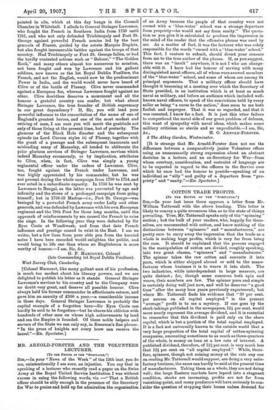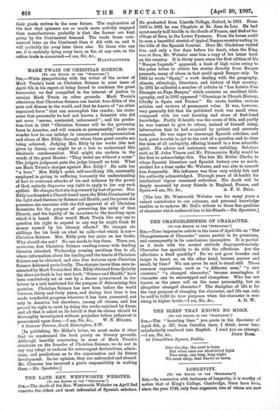COTTON TRADE PROFITS.
Ire rllIl ND1TOR Or Tat SPACTrATOR.'f Sut,—In your last issue there appears a letter from Mr. William Tattersall with the above heading. This letter is likely to convey a quite erroneous idea as to the state of things prevailing. True, Mr. Tattersall speaks only of the " spinning " section ; but the bulk of your readers, who, happily for them- selves, are unconnected with cotton, and know nothing of the distinctions between " spinners " and "manufacturers," are pretty sure to carry away the impression that the trade as a whole is making huge profits, which is very far from being the case. It should be explained that the persons engaged in the manipulation of cotton are divided, roughly speaking, into two great classes, " spinners " and "manufacturers." The spinner takes the raw cotton and converts it into yarn, which is either shipped abroad or sold to the manu- facturer whose business it is to weave it into cloth. The two industries, while interdependent in large measure, are quite distinct ; for, though some concerns both spin and weave, their numbers are few. The spinner pure and simple is certainly doing well just now, and well he deserves "a good time" after the many lean years previously experienced; but where Mr. Tattersall finds his evidence that "30 per cent. per annum on all capital employed" is the present " average" profit is to me a mystery. If one goes by the stock-takings published in the newspapers, 124 per cent, would more nearly represent the average dividend, and it is essential to remember that this dividend is paid only on the share capital, which is but a portion of the total capital employed. It is a fact not universally known to the outside world that a very large proportion of the total capital of cotton-spinning companies, amounting sometimes to as much as three-quarters of the whole, is money on loan at a low rate of interest. A published dividend, therefore, of 124 per cent. is very much lees that 124 per cent on "all capital employed." While, there- fore, spinners, though not coining money at the rate any one on reading Mr. Tattersall would suppose, are doing a very satis- factory business, the same can hardly be said at the present time of manufacturers. Taking them as a whole, they are not doing well; the large Eastern markets have lapsed into a stagnant condition, stocks are increasing, profits are not far from vanishing-point, and many producers will have seriously to con- sider the question of stopping their looms unless demand for
their goods revives in the near future. The explanation of the fact that spinners are so much more actively engaged than manufacturers probably is that the former are kept going by the Continental demand. The trade boom com- menced later on the Continent than it did with us, and it will probably die away later there also. To those who can see, it is certainly dying away here, as far, at any rate, as the cotton trade is concerned.—I am, Sir, &c.,
ISA.NIIPACT1TREB.











































 Previous page
Previous page